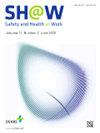长时间工作与血脂异常:一项系统综述和荟萃分析
IF 2.9
3区 医学
Q1 PUBLIC, ENVIRONMENTAL & OCCUPATIONAL HEALTH
引用次数: 0
摘要
本研究旨在通过系统回顾和荟萃分析来评估长时间工作与血脂异常风险以及血脂水平变化之间的关系。方法根据流行病学观察性研究的首选报告项目(PRISMA)和荟萃分析(MOOSE)指南进行系统评价和荟萃分析。通过PubMed, EMBASE和Cochrane图书馆确定研究,数据发布至2024年10月。观察性和干入性研究考察了长时间工作与血脂异常或血脂谱之间的关系。血脂异常的定义基于低密度脂蛋白胆固醇(LDL-C)、高密度脂蛋白胆固醇(HDL-C)、甘油三酯(TG)或总胆固醇水平。使用固定效应模型计算合并优势比(or),使用随机效应模型计算合并非标准化平均脂质水平差异,并进行亚组分析以评估研究设计、脂质概况和暴露定义的影响。结果共有20项研究符合纳入标准。荟萃分析结果显示,长时间工作与血脂异常风险显著增加10%相关(OR = 1.10, 95% CI: 1.04-1.17)。亚组分析显示,在队列研究(OR = 1.13, 95% CI: 1.05-1.20)和高LDL-C水平个体(OR = 1.30, 95% CI: 1.01-1.67)中,相关性更强。观察到HDL-C、LDL-C、TG和总胆固醇的差异,但无统计学意义。结论长时间工作与血脂异常风险增加有一定关系。这些发现为制定以工作场所为基础的血脂异常预防计划提供了证据。本文章由计算机程序翻译,如有差异,请以英文原文为准。
Long Working Hours and Dyslipidemia: A Systematic Review and Meta-analysis
Background
This study aimed to evaluate the association between long working hours and dyslipidemia risk, as well as changes in blood lipid levels, through a systematic review and meta-analysis.
Methods
A systematic review and meta-analysis were conducted in accordance with Preferred Reporting Items for Systematic Reviews and Meta-Analyses (PRISMA) and Meta-analysis Of Observational Studies in Epidemiology (MOOSE) guidelines. Studies were identified through PubMed, EMBASE, and Cochrane Library, with data published until October 2024. Observational and interventional studies examining the relationship between long working hours and dyslipidemia or lipid profiles were included. Dyslipidemia was defined based on low-density lipoprotein cholesterol (LDL-C), high-density lipoprotein cholesterol (HDL-C), triglycerides (TG), or total cholesterol levels. Pooled odds ratios (ORs) were calculated using fixed-effects models and pooled unstandardized mean differences in the lipid levels were calculated using random-effects models, with subgroup analyses conducted to assess the effects of study design, lipid profiles, and exposure definitions.
Results
A total of 20 studies met the inclusion criteria. The resuls of meta-analysis showed that long working hours are associated with a significant 10% increase in dyslipidemia risk (OR = 1.10, 95% CI: 1.04–1.17). Subgroup analyses revealed that the association was stronger in cohort studies (OR = 1.13, 95% CI: 1.05–1.20) and among individuals with high LDL-C levels (OR = 1.30, 95% CI: 1.01–1.67). Differences in HDL-C, LDL-C, TG, and total cholesterol were observed but were not statistically significant.
Conclusion
Long working hours are modestly associated with an increased risk of dyslipidemia. These findings provide evidence for developing workplace-based dyslipidemia prevention programs.
求助全文
通过发布文献求助,成功后即可免费获取论文全文。
去求助
来源期刊

Safety and Health at Work
Social Sciences-Safety Research
CiteScore
6.40
自引率
5.70%
发文量
1080
审稿时长
38 days
期刊介绍:
Safety and Health at Work (SH@W) is an international, peer-reviewed, interdisciplinary journal published quarterly in English beginning in 2010. The journal is aimed at providing grounds for the exchange of ideas and data developed through research experience in the broad field of occupational health and safety. Articles may deal with scientific research to improve workers'' health and safety by eliminating occupational accidents and diseases, pursuing a better working life, and creating a safe and comfortable working environment. The journal focuses primarily on original articles across the whole scope of occupational health and safety, but also welcomes up-to-date review papers and short communications and commentaries on urgent issues and case studies on unique epidemiological survey, methods of accident investigation, and analysis. High priority will be given to articles on occupational epidemiology, medicine, hygiene, toxicology, nursing and health services, work safety, ergonomics, work organization, engineering of safety (mechanical, electrical, chemical, and construction), safety management and policy, and studies related to economic evaluation and its social policy and organizational aspects. Its abbreviated title is Saf Health Work.
 求助内容:
求助内容: 应助结果提醒方式:
应助结果提醒方式:


